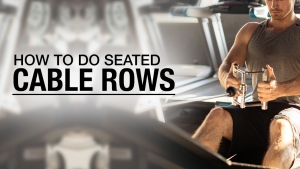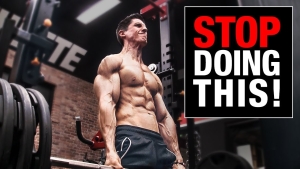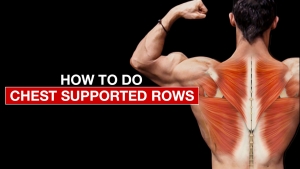
THE PROBLEM WITH TYPICAL BACK WORKOUTS
The back is very unique when compared to other muscles since it is NOT JUST ONE MUSCLE!
So why do we think a few sets of pullups or the bent-over barbell row is enough for muscle growth?
It’s definitely not.
There are two main problems with typical lat focused training, and if this is how you’re training, your back is seriously missing out when it comes to muscle development!
- Lat focused training works only a fraction of the back muscles and doesn’t tap into the complete strength of the back!
- Many people choose repetitive exercises that work the back in the same plane… over and over and over.
For instance, if you look at two common lat-focused back exercises, the pull-up and lat pulldown, they are two major vertical pulling exercises. It’s not necessarily bad to perform them in the same back workout, but you’re overlooking the importance of horizontal pulling if these are the only back exercises you’re doing.
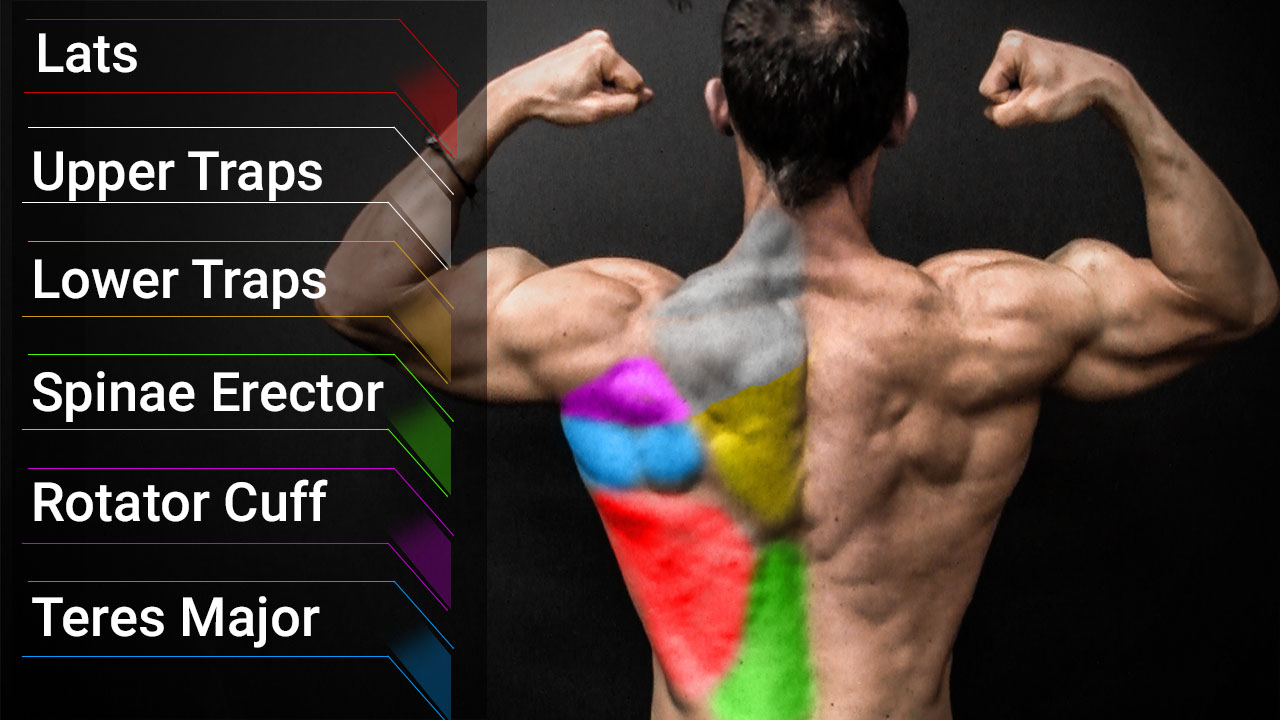
THE 5 MUSCLE GROUPS OF THE BACK
This Back Day Workout needs to hit 5 important upper body major muscles in the back including upper back muscle fibers, mid back muscle fibers and lower back muscle fibers and all of the scapular muscles.
I’ve identified each of these target muscles with the Muscle Markers to help show how each of these muscle groups functions.
WHAT ARE THE MUSCLE GROUPS OF THE BACK?
- Lats
- Upper and Lower Traps
- Low Back / Erector Spinae
- Rotator Cuff Muscles
- Teres Major
THE LATS

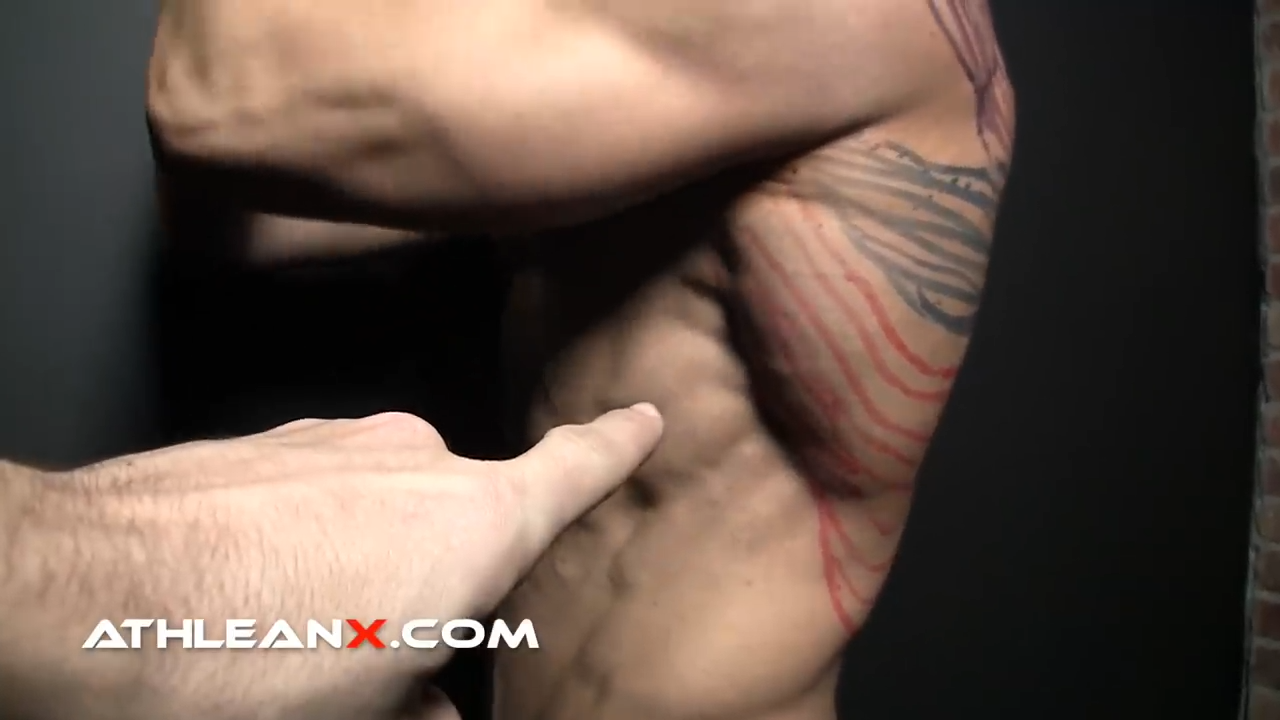
UPPER AND LOWER TRAPS

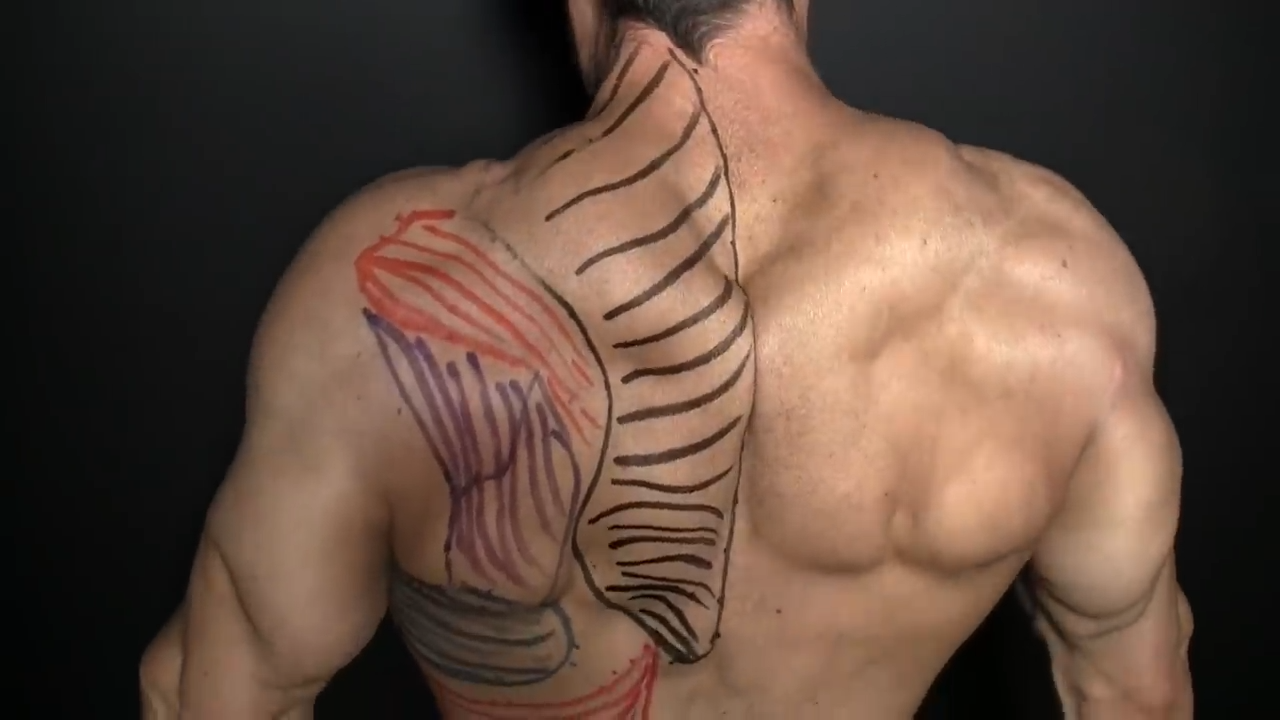
LOW BACK / ERECTOR SPINAE

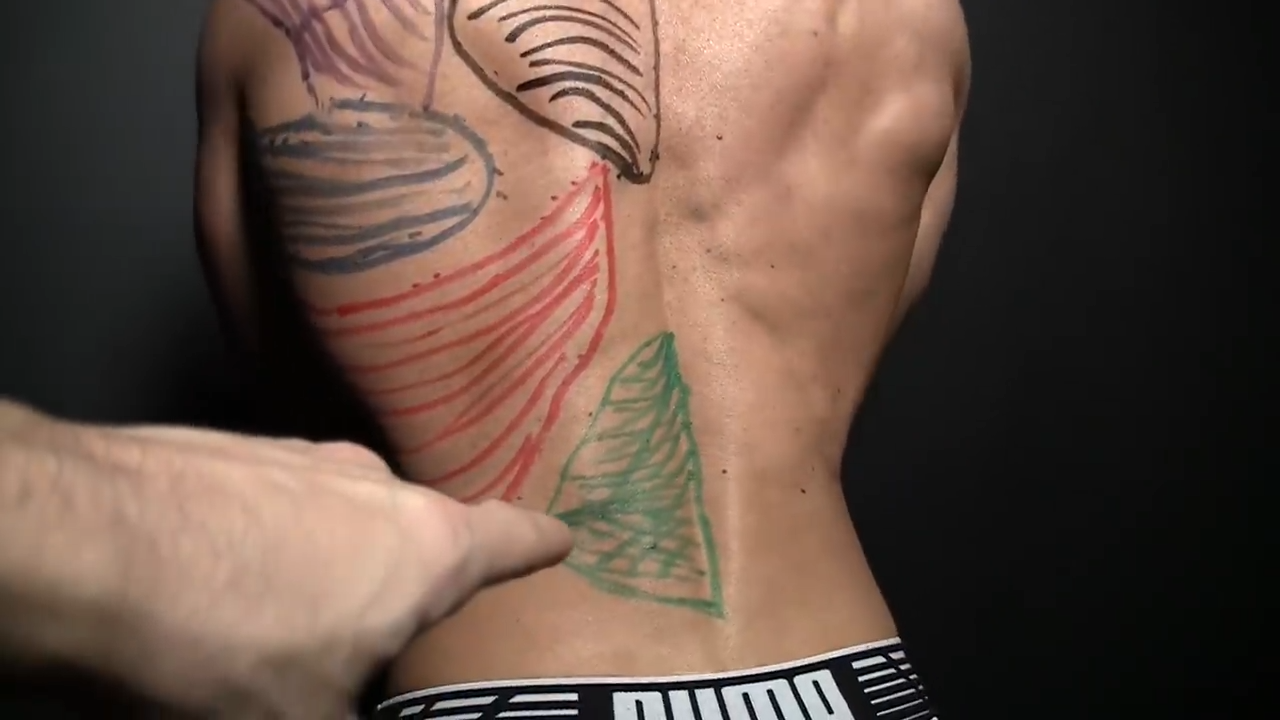
ROTATOR CUFF

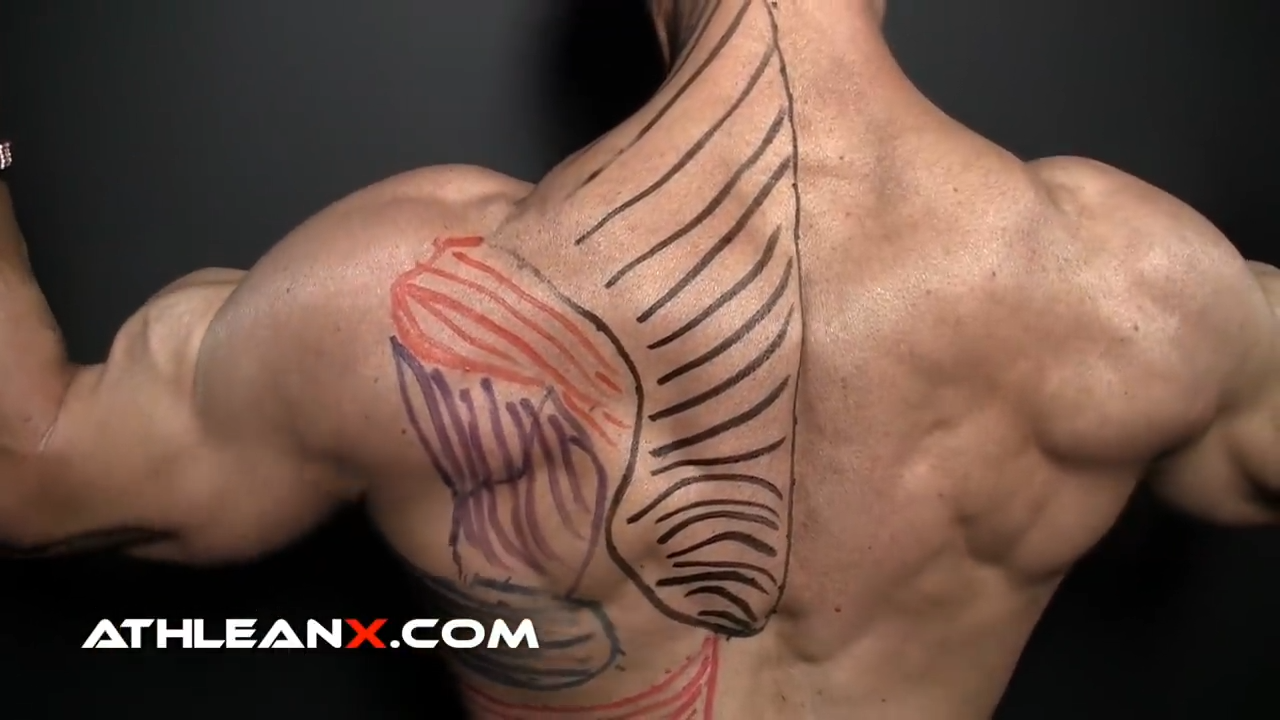
TERES MAJOR


BACK DAY WORKOUT: STEP BY STEP
When I put this complete back workout program together, my goal was to hit the back through its ENTIRE range of motion and hit EVERY FUNCTION, as well as size and strength of the this multi muscle group posterior chain as well.
There are a variety of techniques that I use to achieve this, and we’ll take a brief look at each of them here.
THE WARM UP
Before we get started with our big compound movements we need to make sure that we have warm muscles.
Since the Deadlift is the first compound movement we’ll be working with, we’re going to perform a few submaximal light warmup sets of it. This gives us a good opportunity to practice and set ourselves up with proper form. We also have an opportunity to introduce some Straight Arm Pushdowns using the cable pulley machine with each warmup set of Deadlifts.
This exercise done with cable machines helps to ingrain one of the most important movement patterns you will need to not only perform the Deadlift but all next level back exercises: straight arm scapular strength work.
This reinforces the stability of your shoulder blades, and improves muscle activation to keep that upper body tightness when you do the bar Deadlift.
Starting position is standing at the cable tower with a short straight bar attachment. Begin with arms straight and feet flat on the floor shoulder width apart, and keeping your chest straight and core muscles tight, lower the bar toward your legs in a controlled movement. Return to start position slowly and repeat.
STRAIGHT ARM PUSHDOWN

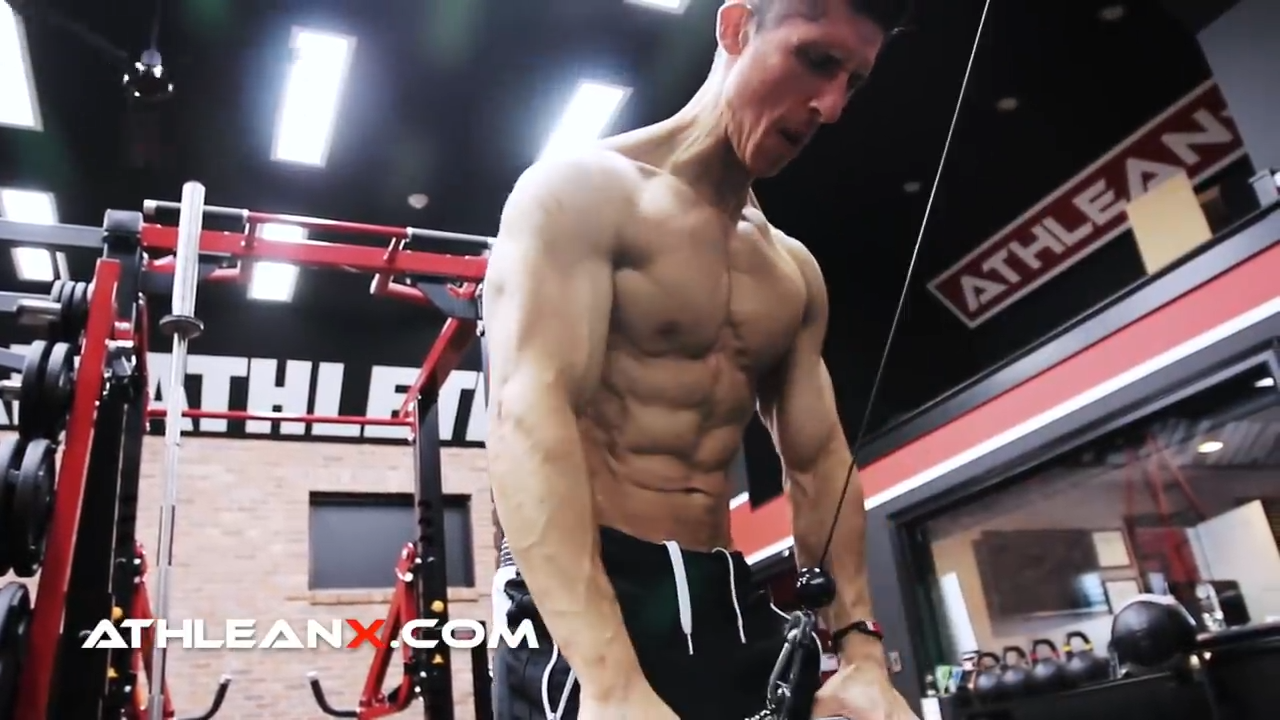
1a.) and 1b.) COMPOUND LIFTS
We’re going to kick this workout off with one of the best compound back exercises that’s going to hit a lot of the areas of the back at once: the conventional Deadlift.
The traps, lats, and lower back all get a heavy dose of progressive overload on this powerhouse of a back exercise!
If you choose a heavy load and refuse to sacrifice your form, this can be an enormous benefit to your overall back muscle development.
BARBELL DEADLIFT

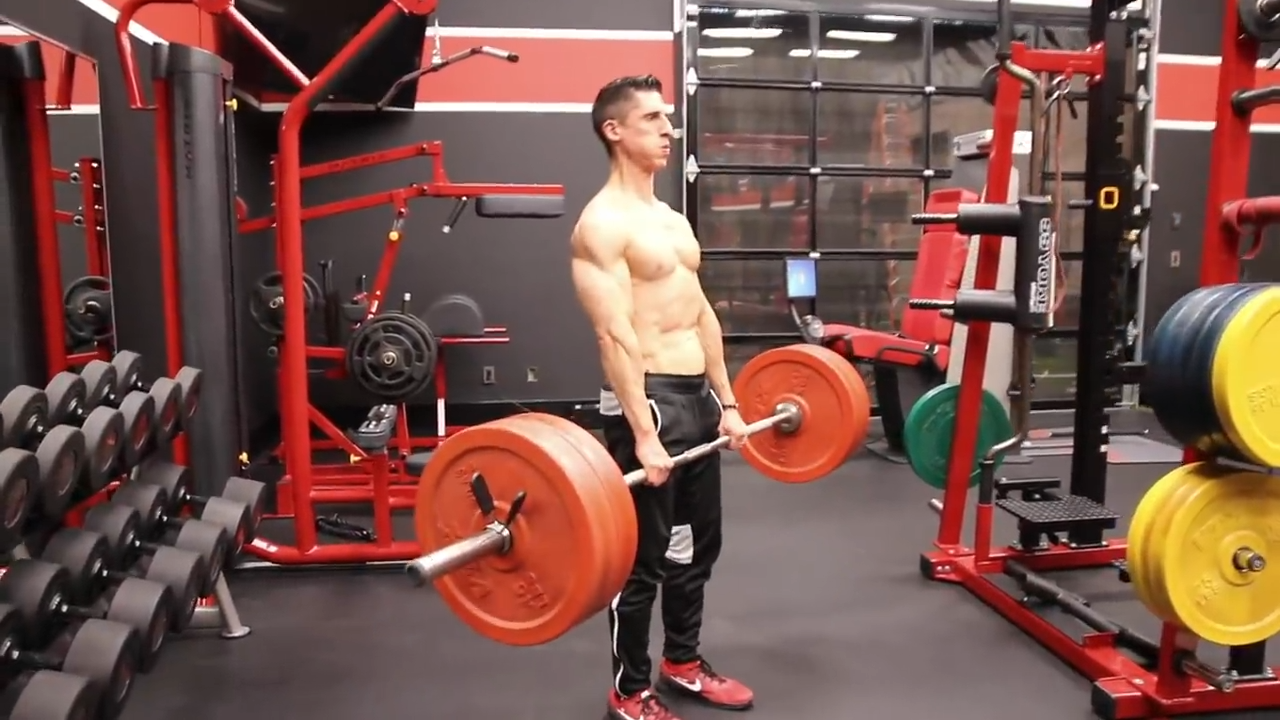
For the first superset we’re going to pair the Deadlift with a Weighted Chin Up.
The deadlift with a loaded barbell is another of the best compound back exercises that can build a lot of back strength, size and overall muscle definition. An additional reason to pair these two movements together is that the loaded dead hang of the Weighted Chin Up allows us to get a great decompressive effect after the heavy load of the Deadlift.
To perform the Weighted Chinup, you can use my dog leash technique to add extra weight in the form of a weight plate. Starting position is in a dead hang on the bar with an underhand grip with palms facing you. Pull yourself up and then slowly lower down to the starting position. Keep your torso upright, spine stable and your core strength engaged during the entire exercise to plug the energy leaks.
WEIGHTED CHIN UP

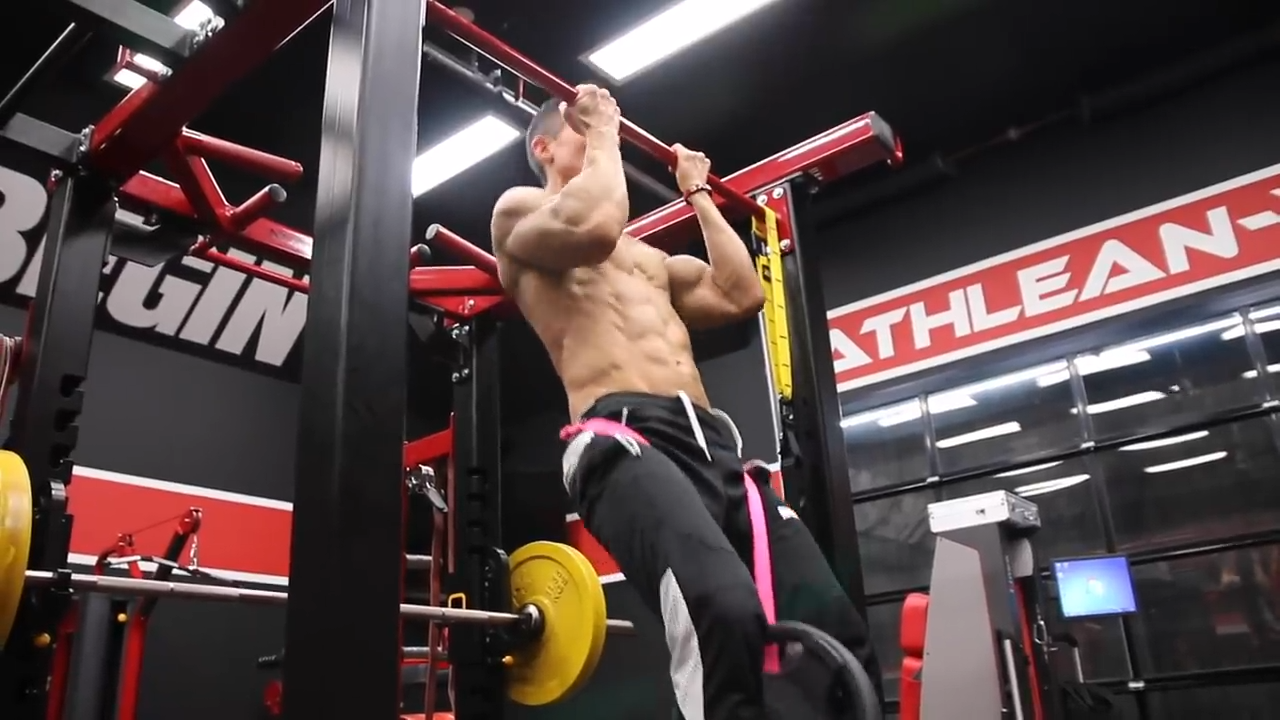
EXERCISE NOTES: Do one warmup set of Deadlifts followed by one set of Straight Arm Pushdowns before the beginning of each regular Deadlift set. In the deadlifts, start with feet flat on the floor, feet shoulder width apart and be sure to keep hips square and abdominal muscles engaged. Starting position is in standing position with a shoulder-width overhand grip, body in hinge position and hands in a shoulder-width grip on the loaded barbell. Start with the loaded barbell at hip height, and lower the torso, hinging at the hips in a controlled movement. Be sure to use proper form for the deadlift to avoid risk of injury. For the first regular Deadlift set use your 8RM and pair it with a Weighted Chin Up, using your 4RM weight for a post-Deadlift decompressive effect. For the second set of the Deadlift go a little heavier to your 6RM and cut the weight in half for your second set of Weighted Chin Ups so you can complete a 8 -10 rep range. Rest 2 minutes between sets of the Deadlift. Maintain proper posture during the deadlift because poor posture can increase your risk of injury.
2a.) and 2b.) SWITCHING GRIPS
It’s important not to get locked in on only one grip in hanging exercises, but instead mix both Chin Ups and bodyweight Pull-ups along with the Deadlift.
If you neglect to switch between an underhand grip and an overhand grip, you lose the chance to work other areas of the back such as the teres major (which in and of itself occupies a large amount of mass above the lats) and therefore lose the muscle gain you will see from your workout routine.
So, we’ll also pair the Deadlift with a Wide Grip Pull-up to incorporate that overhand grip in the second superset to hit those different sets of upper back muscles. We’ll do the Wide Grip Pull-up as a bodyweight movement.
Wide Grip Pull-ups take an overhand grip on the pull-up bar and help us switch up wide and narrow grip pulling exercises. Starting position for the Wide Grip Pull-up is with arms extended in a Y position on the pull-up bar. Pull your torso up to the pull-up bar, keeping the torso upright and a strong core, and pause at the top and before you slowly return to the starting position. Maintain a neutral spine during this exercise. In addition to working the back, this is one of the best pull-up variations that also challenges your grip strength.
WIDE GRIP PULL-UP

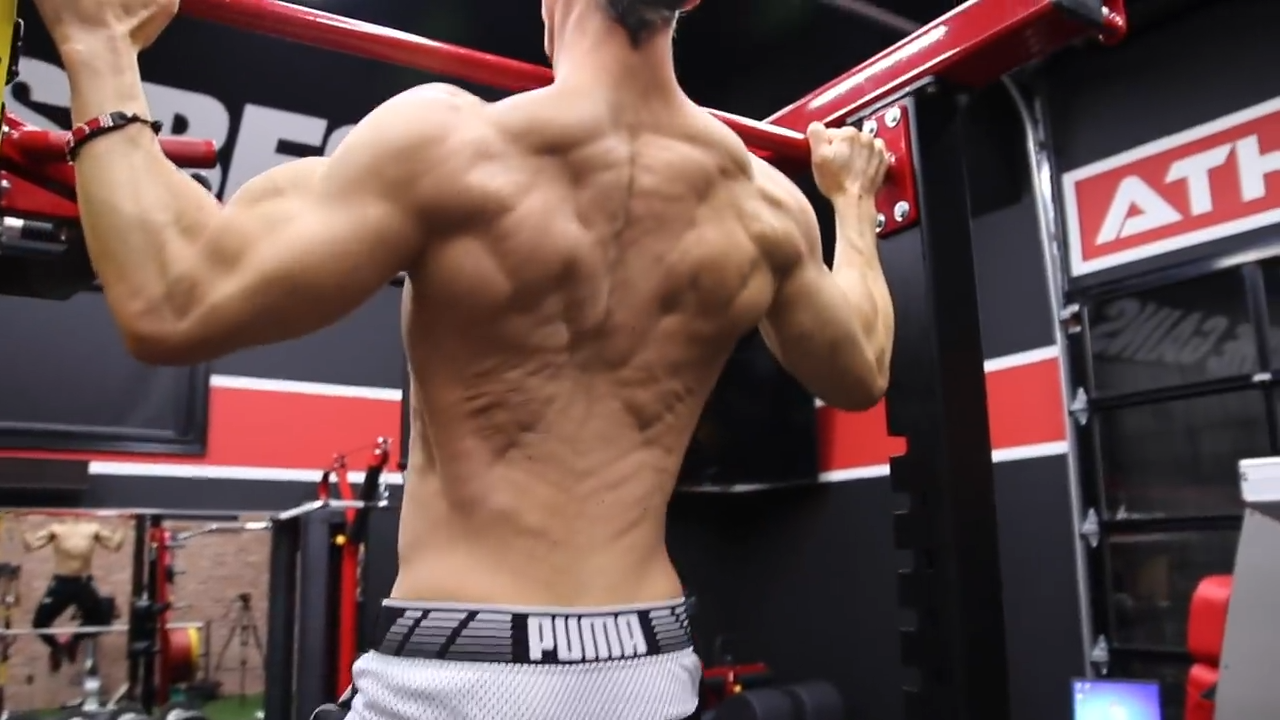
EXERCISE NOTES: The third and fourth set of Deadlifts are our heaviest. Be sure to keep core tight in this exercise. Use your 4RM and pair it with Wide Grip Pullups using straight body weight to hit the terres major a little more than it will the lats. Rest time is 30sec after your third and fourth sets of the Deadlift.
3.) EXPLOSIVITY
My favorite exercise for incorporating explosivity is the Barbell Dead Row.
This heavy barbell row builds off the same movement pattern used for the deadlift, but by allowing you to train explosively, it primes your performance on the deadlift because it shares similar biomechanics. I always say, when you train like an athlete, you always want to speed up what you slow down with your heavier weight training because it helps improve athleticism and strength.
Perform this powerful back exercise as a follow up to the deadlift and you will find that even a heavier weight seems like a lighter load and more able to be accelerated.
Starting position for this barbell row is bending your knees with feet about shoulder width apart, start with a deadlift movement and finish with a barbell rowing movement. As you perform the bent over rows portion, be sure to squeeze your shoulder blades together as you pull the bar toward your torso. Use correct form and maintain your core strength throughout the entire movement to avoid risk of injury.
BARBELL DEAD ROW

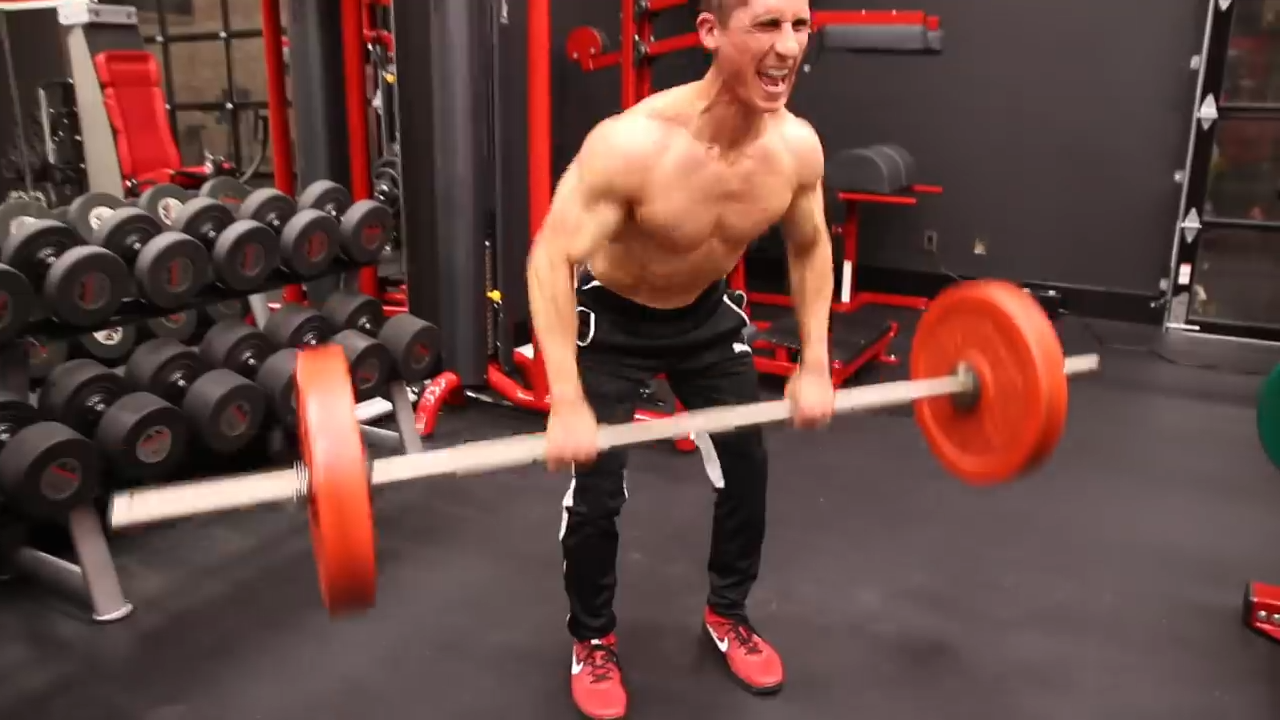
EXERCISE NOTES: In the Barbell Dead Row, starting position is standing with feet flat on the ground in hinge position grabbing onto a loaded barbell. Start by beginning to lift the bar off the ground. We’ll stop at the knees and then continue to drive up and perform the rest of the row pulling the bar up to the belly button, then slowly lower back to standing hinge position. Maintain a slight bend in the knees the entire time. Here the goal is trying to see how quickly we can explode this off the ground. We’re not going to failure on this one. Instead, choose about a 10 to 12RM, and perform 8 to 10 reps. Keep your core tight the entire time.
4.) THE LATS
Dedicating some additional focused tension towards the lats allows you to develop that mind muscle connection that is important for maximizing hypertrophy of the back.
I’ll give you two exercises to choose from, but you’ll just do one of them.
Focus on really squeezing each rep and taking the lats through their full range of motion for optimum effect.
OPTION 1: The Alternating High Cable Row (using the cable pulley machine) done in an alternating fashion is perfect for taking the lats through their entire range of motion. I’m able to get my arm out in front of my body, getting my lat out in full stretch. This is an improvement on the more limited range of motion in a seated cable row.
It still gets it all the way back behind my body, into extension, but also adducted tightly to my side, hitting all the major functions of the lats. You even get a little bit of rotation on the back to really get into more extension.
In addition, working each side of your lats separately helps fix any muscular imbalances that you may have.
Start by placing the cable attachment in an elevated position on the cable pulley, take the cable pulley handle in the left hand and pull your elbow in toward the torso, twisting slightly, being sure to engage the lats and maintain core stability. Return to the start and grab the cable with the right hand, repeating the same motion on the other side.
OPTION 1: ALTERNATING HIGH CABLE ROW


OPTION 2: The Rocking Pulldown (also done with a cable pulley using the lat pull-down attachment) is probably one of best pulldown variations. Instead of being limited in a frontal plane, the rocking motion helps us get more adduction down closer to our side and more extension back behind our body, giving us a better overall lat contraction.
All you have to do is give this a try and I promise you, you’re going to see the results!
You won’t have to sacrifice the weight you’re using to do this, but you’ll get a much better contraction. You can use the same type of weights, maybe dropping down just a plate or two. This focused tension gives you more of an aesthetic benefit on top of the athletic performance and the strength you’re already building in the workout.
OPTION 2: ROCKING PULLDOWN

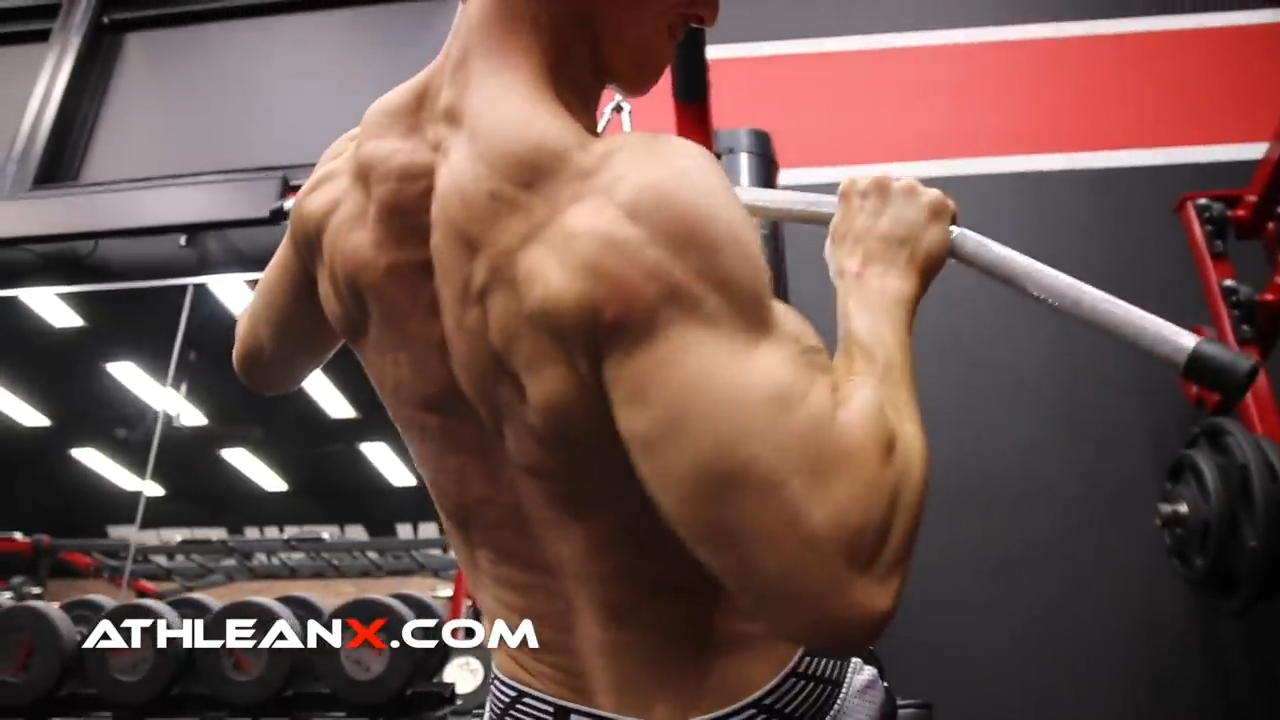
EXERCISE NOTES: Choose between either Option 1 or Option 2 and perform to failure using your 10-12RM. Keep the core tight in both movements.
5.) the SMALLER MUSCLES
Filling in the gaps by hitting the smaller muscles with corrective exercises helps with improved posture and building strength in the entire back, because we’re only as strong as our weakest link.
The rotator cuff is one of these very important and often undertrained muscles. If you’re not training the rotator cuff muscles at least two to three times a week you’re not doing it enough.
The Hyper Y W Combo will allow you to hit both the lumbar erectors and the rotator cuff muscles in a single move. This exercise can be done in a glute-ham raise, or you could do this on a physio ball like I’m showing you.
You will not need to use heavy weights to do this; light weights will light you up in exactly the way you need for best effect. The Y portion achieves muscle contraction in the lower traps and trains them how to fire properly and in the right sequence. The action of the W is to create external rotation at the shoulder to incorporate the muscles of the rotator cuff.
HYPER Y W COMBO

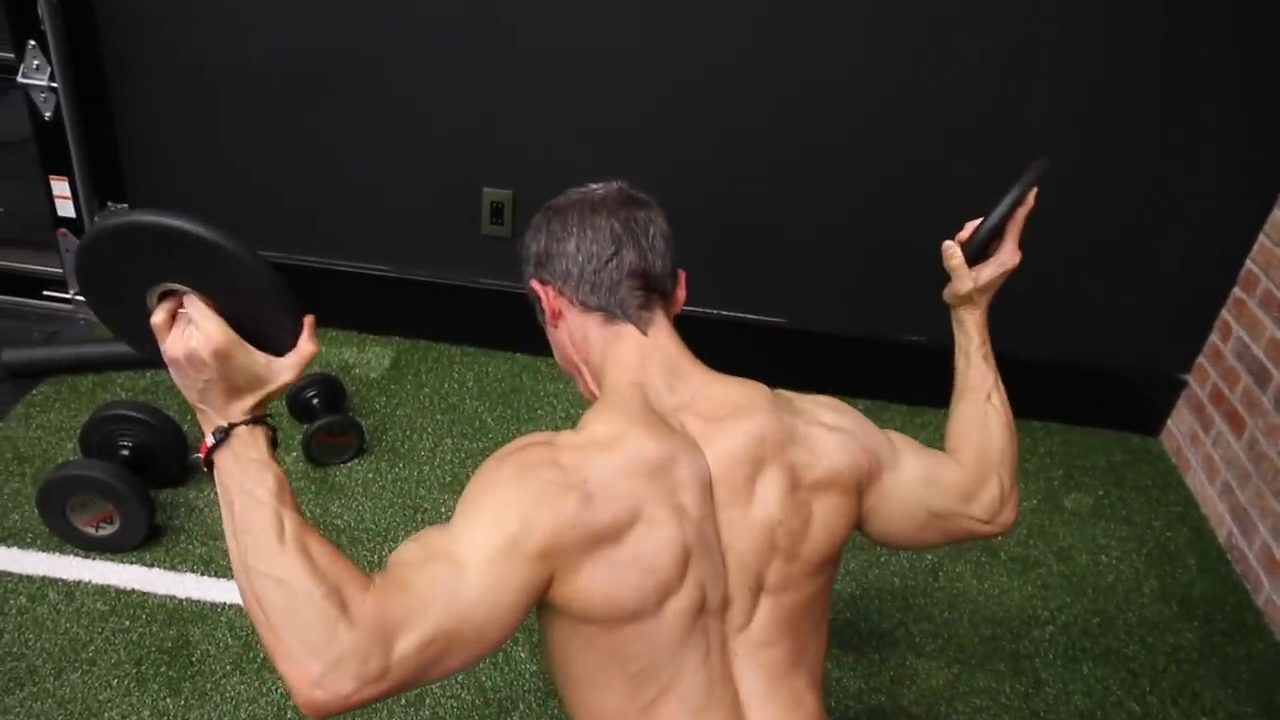
EXERCISE NOTES: Alternate between Ys and Ws every rep and complete 14 to 20 reps. Maintain your core strength the entire time.
6.) the UPPER TRAPS
We’re going to finish this workout with the area you probably focus on more often which is the upper trap.
We’re going to hit it with a Standard Barbell Shrug. You can take a slightly wider grip that puts the angle of the arm more in alignment with the orientation of the fibers of the upper traps, or you can go narrower if it’s more comfortable for you.
STANDARD BARBELL SHRUG

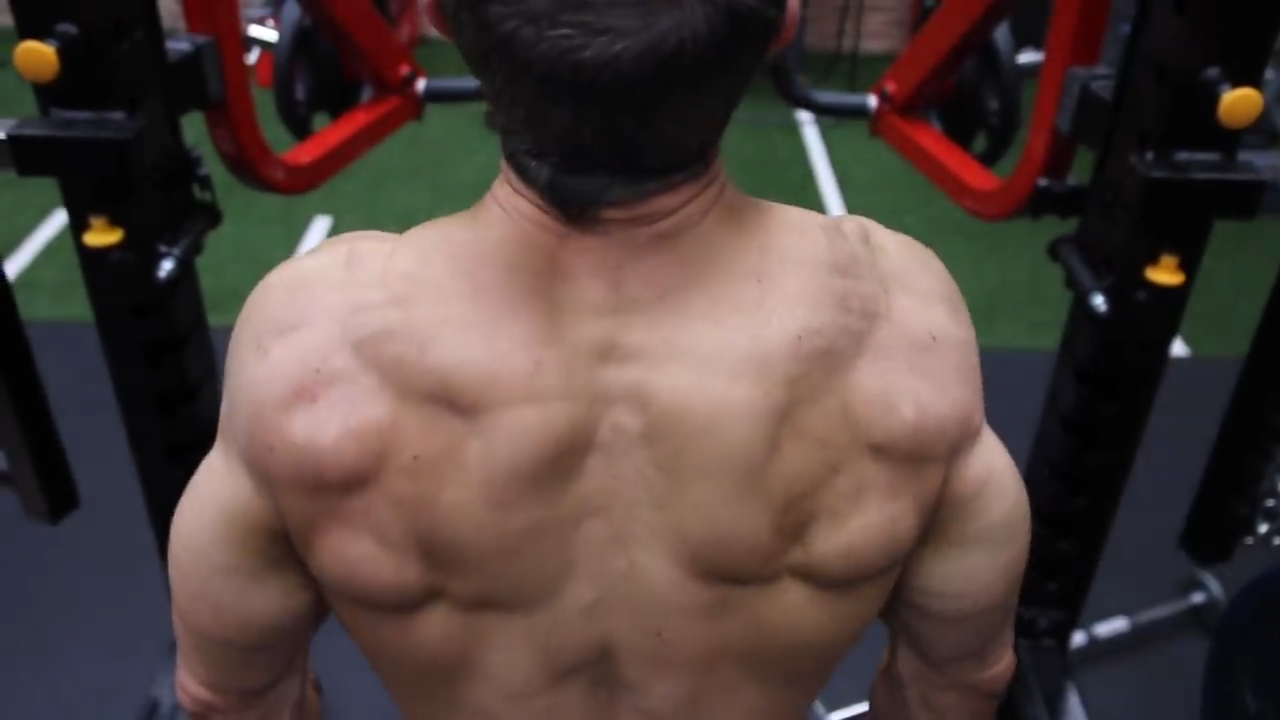
EXERCISE NOTES: We’re doing the Standard Barbell Shrug as a finisher in a ladder format. First, we’re going to work our way up from 1 to 10. For the sickos out there, you’ve got the option to work your way back down from 10 to 1. First you’ll perform a single rep, and then you perform a one second contraction at the top of the shrug. Then you’ll perform 2 reps and perform a 2 second shrug at the top and hold. Perform 3 reps, and then a 3 second shrug, and hold and continue on up the ladder. If, at any time, you can’t perform the hold, or you can’t perform the rest of your reps, put the bar down and rest momentarily. Pick it back up again and work your way through. It’s a killer, but it’s going to give you just enough work and volume in addition to what you’ve already done here with the deadlifts to finish off the traps the right way. Keep the core tight during this exercise.
THE WORKOUT
So, here is the entire BACK DAY WORKOUT step by step, all sets, all reps and rest between exercises for you guys to follow. I promise you, you’re going to see and feel the difference.
BACK DAY WORKOUT
*IMPORTANT NOTE: PERFORM ONE SET OF STRAIGHT ARM PUSHDOWNS FOR EACH WARMUP SET OF DEADLIFTS
- COMPOUND LIFTS:
1A. DEADLIFTS* – 2 SETS (8RM, 6RM) (REST 2 MIN AFTER EACH SET OF DEADLIFTS)
1B. WEIGHTED CHIN UPS – 2 SETS (8RM, 4RM) - SWITCHING GRIPS:
2A. DEADLIFTS – 2 SETS (4RM, 4RM) (REST 30 SEC AFTER EACH SET OF DEADLIFTS)
2B. WIDE GRIP PULLUPS – 2 SETS (BODYWEIGHT TO FAILURE) - BARBELL DEAD ROWS – 2-3 SETS X 10-12RM **(8-10 EXPLOSIVE REPS)
- FOCUSED TENSION – 2-3 SETS (CHOOSE ONE)
4A. ALTERNATING HIGH PULLEY ROW (10-12RM TO FAILURE)
4B. ROCKING PULLDOWNS (10-12RM TO FAILURE) - HYPER Y W COMBO – 2 SETS X 14-20 (ALTERNATE Y’S AND W’S ON EVERY REP)
- BARBELL SHRUG LADDER FINISHER
When you put your back workout together in the format I’m suggesting here, not only do you now hit the back through its full range of motion, but you hit every function of the this multi muscle group posterior chain as well. The supersets and ladders allow for an intensification of the workout to ensure that you are creating enough progressive overload to spark muscle development and see huge strength gains.
This Back Day Workout is just one example of how to apply science to your strength and conditioning workouts. If you want to train like an athlete you’re going to want to put science back in every workout you do. You can do that with the ATHLEAN-X programs and get started right away on building a ripped, muscular, athletic body.

- The back is not just one big muscle group! There are 5 main areas that the Back Day Workout must focus on: lats, upper and lower traps, low back, rotator cuff and teres major.
- There are two big common mistakes with typical lat focused training: it only works a fraction of the back muscles and many people choose repetitive exercises that only work in one plane. Training this way does not maximize your upper body strength.
- When we structure the Back Day Workout, we want to be sure to work ALL the back muscles and incorporate a variety of training elements: compound lifts, switching grips to hit different muscles, explosivity plus targeted work in the lats, the smaller muscles and the traps.
BACK DAY WORKOUT FAQS
Depending on what back exercises you choose, 5 exercises may be enough for back day. You want to choose a wide range of exercises to hit the muscle fibers in all of the back muscles. You also want to incorporate a variety of training elements: compound lifts, switching grips to hit different muscles and explosivity to build muscular power output. Be sure to warmup adequately so that you have warm muscles before beginning your workout. If you don't have access to weight training equipment like barbells and a cable machine, other accessible exercises may be done with a pair of dumbbells or resistance bands. If you have access to a chin-up bar, this will help you to do different variations of exercises like chin-ups and pull-ups to help you switch grips to hit different muscles.
Depending on what back exercises you choose, 5-7 exercises may be enough for back day. You want to choose a range of movement patterns to build lean muscle mass. Your exercise selection for a back muscle building workout should include a compound or full body exercise, switching grips to hit different muscles and additional movements for explosivity. Unilateral exercises are also helpful to correct any muscle imbalances you may have. Be sure to warm up so that you have warm muscles before beginning your workout.
You should plan to train the back 1-2 times per week. The muscle fibers need 1-2 days of rest between sessions to get maximum potential for muscle growth. Be sure to warm up so that you have warm muscles before beginning your workout. Your back day workout should work all the primary muscles in the back including the lats, the upper and lower traps, the low back, the rotator cuff and the teres major.
You shouldn't train the back everyday. Instead, it's best to train the back 1-2 times per week because the muscle fibres need 1-2 days of rest between sessions to get maximum potential for muscle growth.
The deadlift is a great compound exercise that works the entire body. It is a mainstay of upper body training. Be sure to use proper form to avoid neck pain, damage to the shoulder joint, lower-back pain and risk of injury. Also be sure to warmup so that you have warm muscles before your deadlift training. When performing barbell exercises or any heavy resistance training, stick to 4-6 sets per week to give your muscles a chance to repair and grow. The muscles need 1-2 days of rest between sessions to get maximum potential for muscle growth.
REFERENCES

Jeff Cavaliere M.S.P.T, CSCS
Jeff Cavaliere is a Physical Therapist, Strength Coach and creator of the ATHLEAN-X Training Programs and ATHLEAN-Rx Supplements. He has a Masters in Physical Therapy (MSPT) and has worked as Head Physical Therapist for the New York Mets, as well as training many elite professional athletes in Major League Baseball, NFL, MMA and professional wrestling. His programs produce “next level” achievements in muscle size, strength and performance for professional athletes and anyone looking to build a muscular athletic physique.































